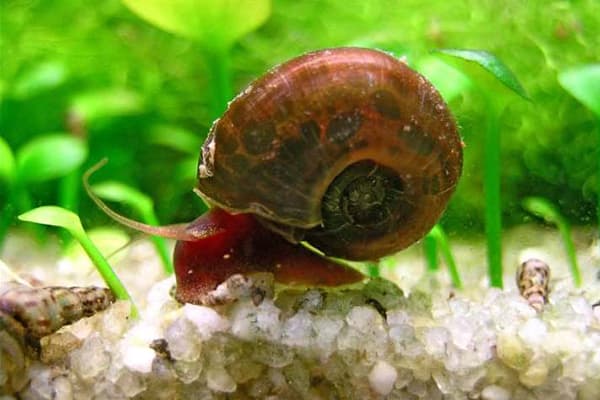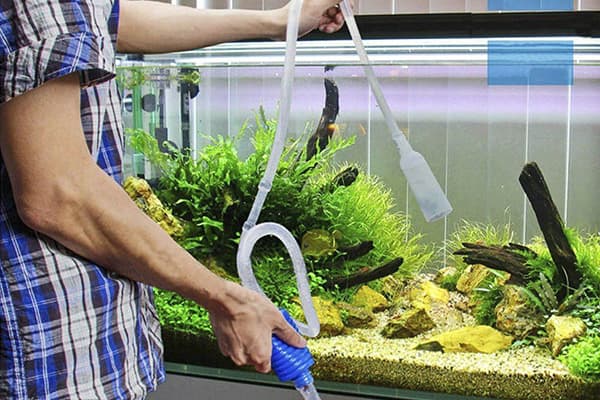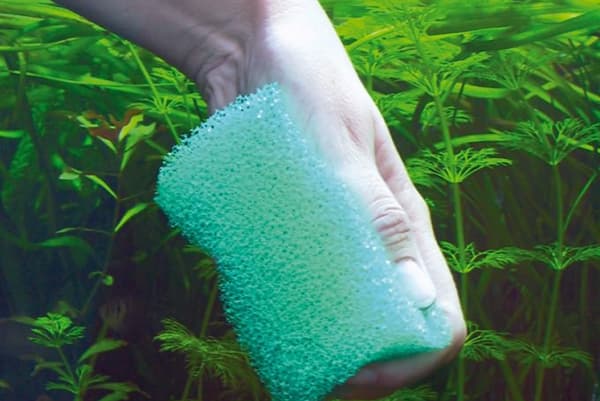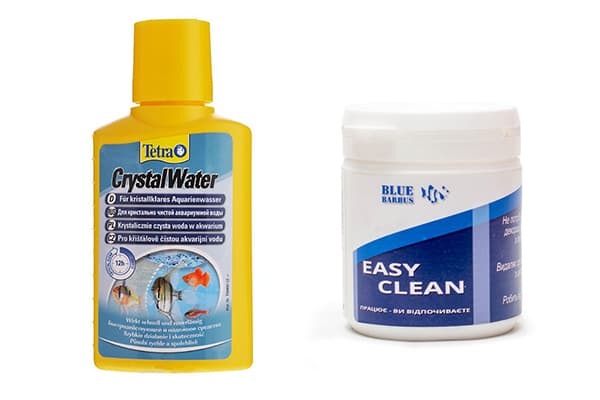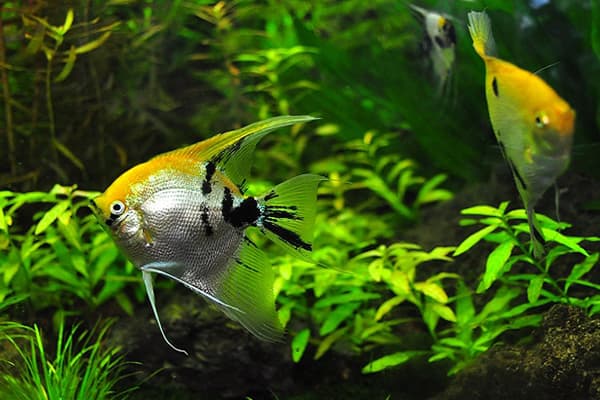We clean the aquarium from green plaque - effective cleaning without problems
Content:
The appearance of green plaque on the walls of the aquarium indicates an imbalance in the ecosystem of the home reservoir. Wall contamination is not only an aesthetic problem. Excessive development of algae can pose a serious threat to all inhabitants, so getting rid of greenery in the aquarium is the owner’s first priority. Algae are an integral part of the natural microflora of the reservoir, but their excessive development of green plaque begins when the conditions of detention are violated.
Causes of greenery
Green plaque on the walls causes the development of a number of algae - green euglena, edogonium nitrate and xenococcus. These algae envelop not only the walls of the vessel, but also soil stones and decorative elements. The algae development cycle is 3 weeks, during which time all spores settle on the walls of the tank. The green bloom begins to lighten, and at this moment it is necessary to get rid of the spores, not allowing the start of a new cycle.
The main causes of the excessive development of green algae:
- Excessive lighting. The aquarium should not be located directly near the window under the influence of direct sunlight, it is necessary to strictly standardize artificial lighting.
- Inadequate cleaning of glass, soil, plants. Spores that linger in the ground, in scratches on the glass, on the vegetation, contribute to the further propagation of algae.
- Incorrectly selected temperature conditions.
- Untimely water change.
- High concentration of phosphates and nitrates as a result of untimely replacement of water. When liquid evaporates, the amount of salts in it increases, the addition of water instead of replacing it exacerbates the situation.
- Excess feed or improper feed, uneaten food residues settle to the bottom, begin to rot.
It is necessary to consider the age of the aquarium. In the new reservoir, the appearance of algae can be caused by the fact that the nitrogen cycle has not yet been established, the aquarium plants are not sufficiently rooted. If a green coating appears in the old tank, it is most likely triggered by a large amount of organic residues. Check to see if the filter is clogged. Having determined the causes of the problem, it will be easier for you to choose methods of dealing with it and remove the greens in the aquarium.
Cleaning methods
Green plaque on the walls does not directly harm the fish. However, it reduces the amount of nutrients entering the plants, leading to further disruption of the biological balance. The amount of oxygen in the water decreases, which negatively affects the fish. If the walls of the tank are covered with a dark green coating, it is necessary to proceed with cleaning. There are several ways to deal with this problem at home.
"Orderlies" aquarium
Experienced aquarists recommend populating the reservoir with inhabitants capable of independently destroying fatal algae.
Top 7 most effective "cleaners":
- Many amateurs breed catfish - pterigoplichitis (brocade catfish), common antiscistrus, and otocinclus (dwarf catfish). Using their suction cups, they remove algae from the walls of the tank, soil, plant leaves, and can clean decor elements. Fish are very unpretentious.
- Girinoheylovye are not able to remove all types of algae; to maintain cleanliness, a large number of individuals are required.
- Viviparous animals such as guppies, mollies, swordsmen are not very effective, a large flock will not leave room for other breeds of fish.
- Fish of the order of cyprinids, as well as lobe, eat algae not so willingly, and they are aggressive towards other inhabitants.
- Shrimps filter the water, remove uneaten food from it, remove residues from the surfaces of the walls, soil, algae. Larger specimens do a better job of this.
- The main advantage of snails is the ability to remove almost all contaminants, the disadvantage is great fertility.
- Increase the number of fast-growing plants floating in the water column or on its surface. The best option is the peppermint, hornwort, limonobium sprouting. This will lead to a decrease in the level of illumination, therefore, a slowdown in the development of algae.
Fish, snails and shrimps can cope with cleaning only with proper lighting, temperature, and feeding conditions.
Aquarium mechanical cleaning
A convenient scraper for cleaning glass from green plaque and a pump for pumping water can be purchased at a specialized store.
You will also need:
- water tank;
- settling water;
- soda to clean the walls;
- sponge.
The main stages of cleaning:
- Put the fish in a container with settled water at the same temperature as in the aquarium.
- Clean the glass with a special plastic or wooden scraper, remove hardened dirt with a blade. Try not to damage the surface, because even in the thinnest cracks algae residues can linger, causing a new wave of greenery in the tank.
Use special sponges and scrapers for cleaning that have not previously come in contact with detergents. Even microparticles of chemically active substances are dangerous for the inhabitants of the aquarium.
- Use a pump to pump out contaminated water.
- Remove equipment parts under water, algae, and decorative items. Rinse, inanimate if necessary, pour over boiling water.
- Use a siphon pump to remove residual feed and excrement from the bottom. Periodically loosen gravel and stones at the bottom. In this way, you can thoroughly clean the soil from contamination.
- Rinse the outside of the aquarium using special detergents or soda.
- Pour clean, settled water, leave for several hours so that the sand settles. Heat the water to the temperature in which the fish are now kept.
- Replace the decorative elements, vegetation, equipment for maintaining temperature and aeration.
- Transplant fish, snails.
If a favorable microclimate has been established in the aquarium, clean the aquarium once a week, replacing approximately a fifth of the water with fresh. If the walls of the aquarium quickly turn green, cleaning should be done more often, replacing the maximum possible amount of water.
Folk cleaning methods
It is undesirable to use chemicals to clean the aquarium, first try using folk remedies:
- Prepare a 10% citric acid solution, process the glass, rinse thoroughly after 15 minutes.
- Remove mucus will help 10% solution of ammonia.
- High cleansing properties have a 15% solution of acetic acid.
Fish and other inhabitants of the aquarium must be transplanted into another container before cleaning.
Chemicals
Specialty stores offer a range of products designed to deal with unicellular algae. When using them, you must strictly adhere to the instructions, since its violation can lead to the death of fish, snails, shrimp and aquarium plants.
Soluble tablets are placed on the ground so that they are freely washed with water. Over the course of the action, the drug gradually releases active substances that inhibit the development of algae. After the expiration date, the tablet must be removed from the water.If you strictly adhere to the instructions, the drug does not harm the inhabitants of the aquarium.
This tool can be used for prevention, reducing the dosage. Enhance the aeration of the aquarium.
Prevention
After cleaning the aquarium from green deposits, follow these steps:
- once a week, replace 15–25% of the liquid with fresh, settled water;
- immediately remove dead plants, preventing rot;
- Do not overfeed the fish, all the poured feed should be eaten in 5 minutes;
- stick to the optimal number of fish in the aquarium, taking into account its volume, do not overload it;
- boil new soil, stones, driftwood and other decorative elements before diving into the aquarium;
- thoroughly rinse acquired plants before planting;
- maintain optimal daylight hours, consider natural light and backlight;
- set the biofilter to the maximum possible power for your aquarium;
- Protect the aquarium from direct sunlight.
Special tests designed to control water parameters are a good way to notice imbalance in the aquarium in a timely manner and take the necessary measures. Regular weekly cleaning of the aquarium will not allow the green bloom to grow to menacing sizes.

